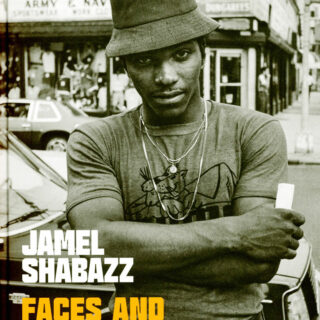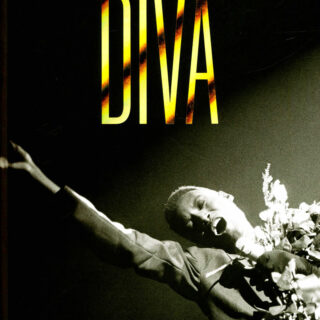A lot of people have had a lot of time on their hands over the past three and a half years, which is why a lot of books are still coming that were first conceived during Lockdown times. Most of them are written not for a particular readership, but rather coffee table enthusiasts. They either have stupid titles based on the well-established Light in the Attic formula (»Get That Booty Bouncin’: Northern Soul in the Flensburg Fjord 1966-1987«) or consist of nothing more than a few stapled-together rave flyers from the olden days. We’re not so sure whether all those trees deserve to be sacrificed for that kind of stuff.
But there are also exceptions worth mentioning and recommending. Wild storytelling and intricate private mythologies, first-class music history lessons about stuff that no-one has really talked about previously, theories on the past, present and future of pop culture, as well as books in between that take the spoken or written word further musically or even make locate, document, and preserve a culture through the medium of photography. In short, there were more than enough books this year that were worth a tree or two, and the following ten are definitely among them.

Christian Pfluger is a transmedia trio: thanks to him, the Weltraumforscher (space explorers) have been around since 1981 in the media of sound, film, image and text. Most recently, the Swiss artist's megalomaniac outsider art project has found a wider audience thanks to numerous compilations on the international underground tape music scenes as well as releases on New York Haunted, A Colourful Storm and, above all, Bureau B, among others. These institutions have now been joined by Ventil Verlag, which has published »Wie die Lia Laternenmacherin wurde und weitere Geschichten aus der Weltraumforschung« (»How Lia Became a Lantern Maker and Other Stories from Space Exploration«), Pfluger's literary psychonautics alongside his cosmic-gothic illustrations. The perfect book for anyone who wants to go far, far away—the only shame is that you’ll need to learn some German to read it. Kristoffer Cornils
Kristoffer Cornils
First interview, first cover story, first fax, first photo shoot without a helmet—the UK fanzine Jockey Slut was very close to Daft Punk back then, at least according to Wikipedia, and they rarely lie on there. The truth is only a secondary source away anyway, so we continue to reproduce it as quickly as possible: this one includes old interviews, new interviews, scribbled-on napkins and even more photos, for example of the equipment collected for the first, second and third albums. It’s good stuff, and it’s also true what they say: »We Were The Robots.«
Christoph Benkeser
The fifth pillar of hip-hop is photography. Jamel Shabazz has been documenting the scene and the city in which it once emerged for over four decades and thus almost from the very beginning. »Faces and Places 1980-2023« is essentially an exhibition catalogue by the photographer, who shot to fame at the age of 21 with the iconic image »A Time of Innocence,« and is less specific than his book »Back in the Days,« which focuses explicitly on hip-hop culture, but also captures the life around it. That’s only logical, since the supporting foundation of the culture’s pillars remains New York fucking City.
Kristoffer Cornils
Enough has been written about blues, jazz, funk and soul, as well as hip-hop. Less attention has been paid to the regional traditions of black North American music, which, beyond Folkways, have never been sufficiently documented with recordings and books. With »Arhoolie Records Down Home Music: The Stories and Photographs of Chris Strachwitz,« Joel Selvin dedicates a carefully put together book to a DIY archivist of roots music such as zydeco and other genres—don't worry, a few well-known names from the blues are also included—which is able to fill any number of gaps in knowledge. Crucial stuff here.
Kristoffer Cornils
n 2023, Britney Spears celebrated a comeback in several ways, bringing a little eccentricity to a pop business whose biggest stars today resemble glossy Teflon products. Spears—alongside Aretha Franklin, Prince and Rihanna, for example—naturally also makes a guest appearance in »Diva: Celebrate the Power and Creativity of Iconic Divas of Opera, Stage, Popular Music, and Film,« edited by curator Kate Bailey. It is a comparatively short yet rich book about a term that is often used and has rarely been explored in such detail.
Kristoffer Cornils
The past is nothing more than an updated memory in the present, hence here’s a new and expanded edition of the bleep bass instant classic »Join The Future.« For the first few hundred pages, jungleist-in-disguise Matt Anniss compiled many interviews with people from Warp, LFO and so on. Now there are a few more pages and interviews, and the foreword is joined by an epilogue—after all, someone still has something to say and a few things had to be corrected. Women still appear rarely in this book, but maybe they’ve been somewhere else in the late eighties.
Christoph Benkeser
Annea Lockwood said goodbye to her long-time partner Ruth Anderson this year with an impressive album and Room40 reissued »The Glass World,« probably the best album by the New Zealand sound artist and composer. And now here’s a book that also preserves her voice and spirit. Hardcore sound nerds Noel Meek and Mattin have produced their »Homage to Annea Lockwood« in an exchange between NZ and the Basque Country, and it is based on a long interview with her that is even accompanied by a CD featuring compositions based on the structure of the conversation. Which is very, very Lockwood.
Kristoffer Cornils
I know Rick Rubin as a shaggy bear who has apparently produced all the records in the world and now pops up on TikTok from time to time, spilling his secrets as a Gandalf with shades. He’s all about »The Creative Act,« which means about existence, the human condition, the whole universe! As an artist, which you either are or intend to be, you need more rather than less of that. That's why the book is 432 pages long and weighs as much as it does, and it’s also why everyone who has read it says it's a must-read. This is fucking Rick Rubin, after all!
Christoph Benkeser
Full-time retromaniac Simon Reynolds has put together a German-language book called »Futuromania« about the so-called future and for this has, er, of course dusted off a few essays from the past—from musings on Donna Summer to Boards of Canada. His interim conclusion: »The future has lost its splendour.« Yeah, well, if the 60-year-old dude says that, it's probably true. A few clever minds have already explained to him that exciting music doesn't just have to come from Europe and the States, but, as he said himself with a laugh, he doesn't »have that much future ahead of him.« In the more immediate one, an English-language version might follow for anyone who lives long enough.
Christoph Benkeser
Did you know that David Lynch wanted to found a university in the former spy station on Berlin's Teufelsberg? Uhhhh … No? It's precisely because of this and other useless but lovely trivia that you should buy »Places« about the capital's subculture and its, er, places. After all, the texts by Daniel Schneider, presented in German and English, are about the 1990s in Berlin and because there used to be a few other clubs there besides Ostgut, Walfisch and the old Tresor, there's also a nice map with lots of pictures—all drawn by Tine Fetz, which alone makes this worth the money.
Christoph Benkeser








